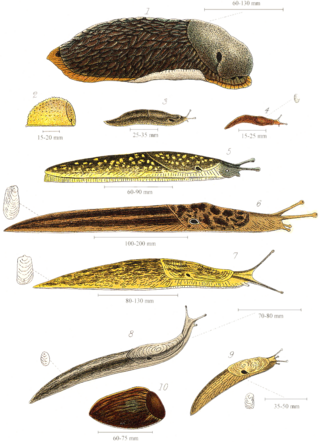
The Dytiscidae – based on the Greek dytikos (δυτικός), "able to dive" – are the predaceous diving beetles, a family of water beetles. They occur in virtually any freshwater habitat around the world, but a few species live among leaf litter. The adults of most are between 1 and 2.5 cm (0.4–1.0 in) long, though much variation is seen between species. The European Dytiscus latissimus and Brazilian Megadytes ducalis are the largest, reaching up to 4.5 cm (1.8 in) and 4.75 cm (1.9 in) respectively. In contrast, the smallest is likely the Australian Limbodessus atypicali of subterranean waters, which only is about 0.9 mm (0.035 in) long. Most are dark brown, blackish, or dark olive in color with golden highlights in some subfamilies. The larvae are commonly known as water tigers due to their voracious appetite. They have short, but sharp mandibles and immediately upon biting, they deliver digestive enzymes into prey to suck their liquefied remains. The family includes more than 4,000 described species in numerous genera.

Tapinoma is a genus of ants that belongs to the subfamily Dolichoderinae. The genus currently comprises 74 described species distributed worldwide in tropical and temperate regions. Members of are generalized foragers, nesting in a wide variety of habitats, ranging from grasslands, open fields, woodlands, to inside buildings. The majority of species nest in the ground under objects such as stones or tree logs, other species build nests under bark of logs and stumps, in plant cavities, insect galls or refuse piles.

Ixodes is a genus of hard-bodied ticks. It includes important disease vectors of animals and humans, and some species inject toxins that can cause paralysis. Some ticks in this genus may transmit the pathogenic bacterium Borrelia burgdorferi responsible for causing Lyme disease. Additional organisms that may be transmitted by Ixodes are parasites from the genus Babesia, which cause babesiosis, and bacteria from the related genus Anaplasma, which cause anaplasmosis.

Slug, or land slug, is a common name for any apparently shell-less terrestrial gastropod mollusc. The word slug is also often used as part of the common name of any gastropod mollusc that has no shell, a very reduced shell, or only a small internal shell, particularly sea slugs and semi-slugs.

Parasitengona is a group of mites, variously ranked as a hyporder or a cohort, between the taxonomic ranks of order and family.
The Southern Africa Association for the Advancement of Science (S2A3 or S2A3) is a learned society, originally known as the South African Association for the Advancement of Science (SAAAS). Established in 1902, its principal aim is to increase the public awareness and understanding of science, engineering and technology, and their role in society, by means of various awards and by communicating the nature, processes, ethics, and excitement of science. Membership is open to all.

Rhizoglyphus is a genus of mites in the family Acaridae. It has a worldwide distribution and is often associated with the bulbs, corms or tubers of plants.

Raphitomidae is a family of small to medium-sized sea snails, marine gastropod mollusks in the superfamily Conoidea.

Glycymeris, common name the bittersweet clams, is a genus of saltwater clams, marine bivalve molluscs in the family Glycymerididae.

Geophilus is a large, heterogeneous genus of soil centipedes in the family Geophilidae largely considered to be synonymous with Brachygeophilus. The generic name first appeared in Brewster's Edinburgh Encyclopaedia in 1814 as Geophilus electricus. This genus has a Holarctic distribution.

Hydryphantidae is a family of mites in the order Trombidiformes. There are more than 30 genera and 130 described species in Hydryphantidae.
Thyasidae is a family of mites in the order Trombidiformes. There are about 7 genera and more than 30 described species in Thyasidae.
Albia is a genus of mites in the family Aturidae. There are about 18 described species in Albia.










